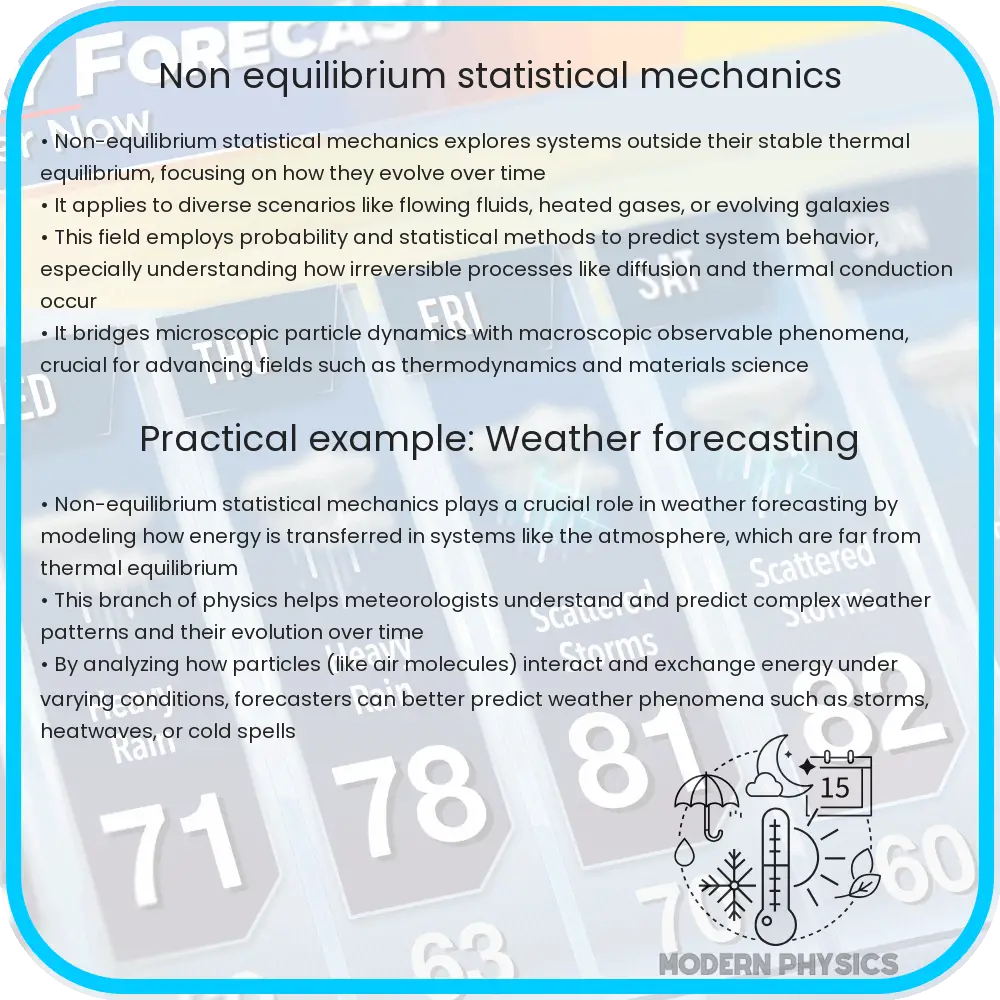Explore the dynamic world of Non-Equilibrium Statistical Mechanics, its theories, challenges, and wide-ranging applications in modern science.

Understanding Non-Equilibrium Statistical Mechanics
Non-Equilibrium Statistical Mechanics is a fascinating and complex field that extends beyond the traditional boundaries of classical thermodynamics and equilibrium statistical mechanics. It delves into the study of systems that are not in thermodynamic equilibrium, a state where macroscopic properties do not change over time. This discipline is crucial for understanding various natural phenomena and technological processes that occur far from equilibrium.
Dynamics of Non-Equilibrium Systems
At the heart of non-equilibrium statistical mechanics are the dynamic processes. Unlike equilibrium systems, where time does not play a significant role, non-equilibrium systems are defined by their temporal evolution. This includes processes like diffusion, thermal conduction, and fluid flow, where the system evolves towards equilibrium but is perpetually driven away from it due to external forces or internal fluctuations.
Role of Fluctuations
Fluctuations are integral to non-equilibrium systems. These random deviations from the mean behavior are not merely perturbations but can drive essential processes in the system. For example, in the case of Brownian motion, the erratic movement of particles is a result of thermal fluctuations. The study of these fluctuations gives insight into the microstates of the system and can help in understanding macroscopic properties.
Understanding Complex Systems
Non-equilibrium statistical mechanics is especially useful in the study of complex systems. These systems, which include biological organisms, ecosystems, and even certain socio-economic systems, are inherently out of equilibrium. They are characterized by constant energy and matter flow, maintaining a state far from equilibrium. Understanding the principles of non-equilibrium mechanics helps in comprehending the behavior and evolution of these complex systems.
One of the key challenges in this field is the lack of a general theoretical framework akin to the Gibbs ensemble theory in equilibrium statistical mechanics. However, advancements are being made with tools like stochastic processes, non-linear dynamics, and chaos theory.
Applications in Various Fields
The principles of non-equilibrium statistical mechanics find applications in a wide range of fields. From materials science to biophysics, understanding non-equilibrium processes is crucial. For instance, in semiconductor physics, the behavior of electrons and holes under external electric fields is a non-equilibrium process vital for the functioning of electronic devices.
In conclusion, non-equilibrium statistical mechanics offers a comprehensive framework to understand and predict the behavior of systems under dynamic conditions. Its applications are vast and integral to numerous scientific and technological fields.
Advanced Theories and Mathematical Models
Advancements in non-equilibrium statistical mechanics have led to the development of sophisticated theories and mathematical models. One pivotal concept is the fluctuation theorem, which provides a quantitative description of the probability of observing fluctuations away from thermodynamic equilibrium. This theorem has profound implications in understanding irreversible processes and the arrow of time.
Another significant area is the study of non-equilibrium phase transitions and critical phenomena, where systems exhibit behavior that is dramatically different from their equilibrium counterparts. These studies are crucial for understanding phenomena like the formation of patterns in chemical reactions and the dynamics of spin systems out of equilibrium.
Challenges and Future Directions
Despite its advances, non-equilibrium statistical mechanics faces several challenges. One of the main difficulties is the absence of a universal principle like the Boltzmann distribution in equilibrium statistics. Systems far from equilibrium may not have well-defined temperature or entropy, making it challenging to apply traditional thermodynamic concepts.
Future research is likely to focus on developing a more unified framework that can encompass a wider range of non-equilibrium phenomena. This includes exploring the interplay between quantum mechanics and non-equilibrium statistical mechanics, which is particularly relevant in the study of quantum computers and other nanoscale devices.
Real-World Applications and Technological Impact
The practical applications of non-equilibrium statistical mechanics are vast and impactful. In the field of environmental science, it helps in modeling climate dynamics and understanding ecological systems. In medicine, it aids in the study of cellular processes and the development of drugs that target dynamic biological systems.
Technologically, this field is crucial for the advancement of nanotechnology and materials science. The design of new materials and nanodevices often relies on understanding their behavior under non-equilibrium conditions.
Conclusion
Non-Equilibrium Statistical Mechanics represents a crucial area of study in modern physics and applied sciences. Its ability to describe, predict, and manipulate systems away from equilibrium has profound implications across a wide spectrum of scientific and technological fields. As research continues, we can expect deeper insights and more sophisticated theories that will further our understanding of the universe at both the macroscopic and microscopic levels. The future of non-equilibrium statistical mechanics is not only promising but essential for the continued advancement of science and technology.
In summary, this field, with its blend of theoretical challenges and practical applications, stands at the forefront of our quest to understand the complex dynamics of the world around us.
